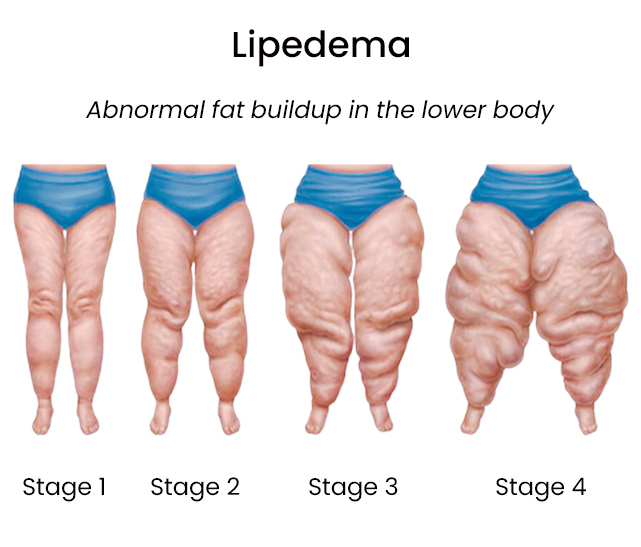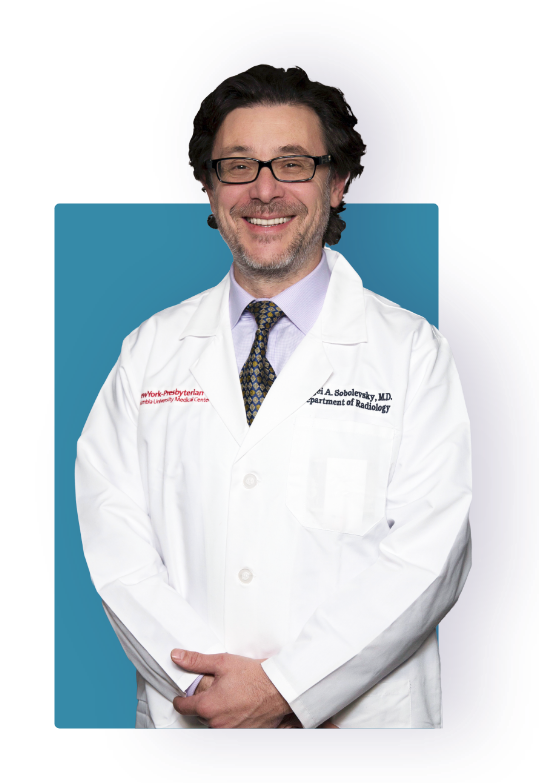Are you struggling with body weight that won’t go away no matter how much you exercise or watch your diet? Many women do not realize that excessive weight in their legs is resulting from lipedema, a condition characterized by an abnormal build-up of fat cells on hips, legs, buttocks, and sometimes arms. Visit Downtown Vein & Vascular Center to learn more about this condition, its causes, and available treatment options. Dr. Sergei A. Sobolevsky makes an accurate diagnosis based on the development of fatty tissues on your legs and thighs and comes up with the best lipedema treatments to help you live a normal life again.
What Is Lipedema?
Lipedema is a disease of inflamed fat cells that occurs when fat is distributed irregularly beneath the skin, usually in the buttocks and legs. Even though it begins as a cosmetic issue, it can result in pain and other symptoms.
Also known as lipodema, it is often mistaken for obesity or lymphedema due to the swelling it causes in the lower parts of the body. Even though lipedema is not caused by obesity, more than half of patients with this condition are overweight. It can also affect the arms, but it is in rare cases. It may affect up to 11% of women.
Lipedema is not a life-threatening or limb-threatening condition, but it can affect your quality of life and ability to move easily, and participate in activities you like.

Read more: What Causes Hemosiderin Staining?
Symptoms of Lipedema
Patients with lipedema have large hips and legs in comparison to their waist and upper body. Their legs may appear swollen, but their feet will remain normal-sized. Pressure on the legs can cause significant pain, making it uncomfortable for lipedema patients to get a massage of the legs or wear compression stockings.
Unlike obesity, lipedema targets the legs and thighs, and sometimes arms. Also, it does not start in the lower feet like lymphedema, but in the upper legs and usually affects both legs. Hormonal fluctuations like menstrual cycles can worsen the symptoms.
Other symptoms include:
- Bruising of legs, even without a known injury
- Strange, hard to describe sensations in the legs
- Restless legs, even at night
- Clumping of fat in areas like outer hips and thighs
- A sensation of pain even with light pressure
- Large lower half and column-like legs that are tender and bruise easily
- Growing heaviness in the lower body which later begins to collect in the arms
- A buildup of fluid in the body resulting in lymphedema
- Legs that are tender to touch
If not treated timely, lymphedema can lead to other problems such as infections, delayed healing of wounds, development of scar-like tissues called fibroids, and hardened skin in the legs. Lipedema can be managed well with medical help and proper treatment. Some people with lipedema can have vein disease that can complicate their condition and treatment.
As the condition gets worse, lipedema can affect your ability to walk. Many people also experience emotional symptoms, such as being embarrassed, anxious, and depressed as the lower part of their body grows larger, and they are unable to participate in routine activities like before.
How Is Lipedema Diagnosed?
There is no specific diagnostic test, and there are no blood or urine markers to test for. Healthcare providers make a diagnosis by conducting a physical examination and asking you about your medical history.
The factors your doctor will consider include the following:
- Swelling that is on both sides of your body but not your hands and feet
- If the texture of your skin tissue in the affected areas feels different from other areas, e.g., softer and has dimples in it
- If there are small lumps, like peas or gravel, in the fat
- The areas may feel colder to touch
- When did the fatty areas start developing?
- If your attempts to lose weight worked for the affected area
- Does standing for a long time, hot weather, and plane trips worsen the swelling and pain?
- If you feel decreased strength in your lower legs
- If any other family members have similar symptoms or have been diagnosed with the condition
Even though it is dismissed as obesity and lymphedema, lipedema has specific symptoms. If you notice any unusual symptoms that do not seem to have any known cause, call your healthcare provider right away for accurate diagnosis and treatment.
How Is Lipedema Treated?
An accurate diagnosis of this condition is crucial for treatment. Lipedema is often confused with obesity and lymphedema due to the confusing symptoms and the inability of the patients to explain what they are feeling to the healthcare provider.
Each individual suffers from a different issue, making this condition debilitating and frustrating to manage. Thus, treatment requires special planning and careful consideration to provide desired relief and address any other ongoing medical condition.
Lipedema can be managed and treated with the following:
Compression
Compression garments keep the inflammatory products out of the legs and prevent them from building back. They should be worn during the day and only removed at night, before you go to bed. Persistent use of well-fitting compression garments, as suggested by your healthcare provider, can help reduce the remodeling and enlargement of the affected limbs.
There are knee-high socks, thigh-high stockings, pantyhose, and leggings. Sometimes compression garments are uncomfortable, so make sure to discuss this with your doctor to prevent further complications or swelling. Try starting with lighter compression (15-20 mmHg), and work up to tighter compression (20-30 mmHg) for best results.
Some patients may also benefit from a device known as a pneumatic compression pump which consists of sleeves for the legs that inflate with air, gently massage the legs and encourage the flow of lymphatic fluid.
Diet
An anti-inflammatory diet has proved beneficial for people suffering from lipedema. It is best to avoid processed and pre-made foods and go with homemade, whole-food options. Switching from saturated fats and meats to a plant-based diet with occasional lean proteins may help with symptoms.
Incorporating natural anti-inflammatories, like garlic and turmeric with fresh fruits and vegetables, and lots of fluids in your diet can help with lipedema.
Weight Management
Weight management is essential to slow down the progression of the disease. Accumulation of fat in the body can lead to development of symptoms or worsen them. However, it is also essential to note that weight loss does not cure the discomfort associated with lipedema. It is only a stand-alone therapy that may help to manage things.
Exercise
Regular, low-impact exercise is essential to force inflammatory products in the tissues out of the legs. Exercise is also beneficial for controlling or reducing the symptoms of hormonal fluctuations.
Medical Treatment Options
For many people, lifestyle changes only cannot manage lipedema or change the size of their legs. Your healthcare provider may recommend the following treatment options to ease your symptoms and provide relief.
Liposuction
Liposuction can help lipedema patients by removing inflamed fat cells from the affected parts. It is crucial to find an experienced plastic surgeon who specializes in the disease and reduces the size of fat deposits most effectively.
Vascular Care
Some patients with lipedema may also suffer from superficial vein disease that contributes to their symptoms. Not all vein disease is obvious, but some signs and symptoms include spider or varicose veins, swelling in the legs, and darkening of the skin around the calves or ankles. Heaviness or fatigue of the leg with itchiness or restlessness in the affected legs are signs of venous issues that need medical attention.
If you suspect you have lipedema, consult a vascular specialist to learn more about your symptoms and what they indicate. Top vascular specialists are well informed and experienced about the most common causes of leg pain or swelling and make an accurate diagnosis based on your condition and rule out underlying conditions.
Read more: How to Tell If You Need a Lymphatic Drainage Massage
Difference Between Lymphedema and Lipedema
The medical condition known as lipedema, sometimes called lipoedema, and lymphedema, are frequently linked to each other due to their similarities. However, it is important to know that these two ailments have very different effects on the body.
It is necessary to have a clear understanding of the symptoms and causes of each before checking out the appropriate management and treatment options for these conditions. The primary difference between lipedema and lymphedema is that the former is characterized by an accumulation of fatty tissue in the affected areas, whereas lymphedema is caused by the collection of lymph fluid in these tissues.
Lymphedema occurs when there is a blockage in the lymphatic system. Because of the obstruction, the lymph fluid cannot drain as it should, which leads to the buildup of extra fluid that produces swelling. Lymphedema may develop on its own, either due to genetic factors, pregnancy, and advanced age, or it may occur as a result of infection of the lymph nodes, exposure to radiation therapies for cancer, or damage to the lymph nodes during surgery.
Lipedema, also called painful fat syndrome, is a completely different chronic condition. There are no known cases of lipedema. It is believed to be an outcome of abnormal accumulation of fat cells in the tissues under the skin. Lipedema patients usually have normal lymphatic function unless the extra fatty tissue that occurs in lipedema compress and strangles the delicate lymphatic tracts and veins and obstructs lymph fluid movement.
Lipedema does not go away on its own, rather it can gradually worsen. Getting a diagnosis and medical help as soon as possible can make it easy to manage the symptoms and prevent them from affecting your quality of life.
You don’t have to suffer from disproportionate fat accumulation in the hips and legs and face embarrassment. At Downtown Vein & Vascular Center, you can look forward to the highest quality treatment and care to manage your condition and prevent further complications for long-term wellness. Dr. Sergei A. Sobolevsky determines whether it is lipedema or some underlying issue causing your symptoms and develops a treatment plan that helps to get rid of the bulges of fatty tissues on the thighs and legs safely and effectively. The endovascular specialist also recommends lifestyle changes and remedies to manage your condition and ease the accompanying pain and swelling.

Sergei Sobolevsky, MD, is a leading specialist in endovascular medicine with experience in vascular and interventional radiology. Dr. Sobolevsky has decades of experience in the field, with over 25,000 procedures performed, accumulating extensive experience in image-guided minimally invasive medicine, diagnosing and treating a range of conditions.
Dr. Sobolevsky earned his Doctor of Medicine (MD) degree in 1997 from the University of Colorado School of Medicine. He received his specialty clinical training in vascular and interventional radiology at Harvard University. Later, he earned his MBA from the MIT Sloan School of Management. Recognized as a Castle Connolly Top Doctor and named to the Top Doctors New York Metro Area in 2020, 2021, and 2022, Dr. Sobolevsky is licensed in multiple states, has delivered presentations at numerous institutions in the US and abroad, and now acts as a clinical advisor for the biomedical industry. He also held multiple positions in the field during his career, including Chief of Vascular and Interventional Radiology at the Columbia University Medical Center in New York, NY, Senior Vice President in Clinical and Regulatory Affairs at Artann Laboratories in North Brunswick, NJ, and Medical Director at the American Endovascular and Amputation Prevention Center in Brooklyn.
More About Dr. Sobolevsky

